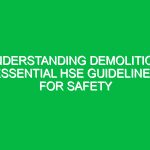Introduction
Good morning team! Today, we are gathered for our toolbox talk on an essential topic that affects every aspect of our work: How We React to Our World. Understanding how our reactions shape our Environment is crucial in the context of Health, Safety, and Environment (HSE). Our responses to various stimuli—whether they’re Hazards, stressors, or even the actions of our colleagues—play a significant role in maintaining a safe workplace. Let’s dive into how our reactions can either enhance or compromise Safety and how we can foster a proactive approach to our daily operations.
The Significance of Our Reactions
Every day, we encounter situations that require quick thinking and appropriate responses. The way we react can lead to either positive outcomes or dangerous situations. For example, consider a scenario where an employee notices a colleague working near a hazardous material without proper protective equipment. If the observer reacts promptly and informs the colleague, it can prevent potential accidents. Conversely, if they ignore the situation, it could lead to serious health risks.
In this toolbox talk, we will explore how our reactions influence Safety, the importance of situational awareness, and how we can cultivate a culture of proactive responses in our workplace.
Understanding Situational Awareness
Situational awareness involves being aware of your surroundings, understanding the dynamics of your environment, and anticipating potential risks. It’s a skill that can be developed through practice. The first step is to actively observe what is happening around you. Ask yourself:
- What are the potential Hazards in my immediate environment?
- How are my colleagues behaving, and could their actions pose a risk?
- What changes have occurred since my last assessment of this situation?
By consistently asking these questions, you enhance your ability to react appropriately to potential dangers. For instance, if you notice that the floor is wet and someone is carrying a heavy load, your reaction might be to alert them to the slip hazard, thus preventing a potential accident.
The Role of Training and Preparedness
Training is an integral part of ensuring that we know how to react effectively. Regular safety training sessions help us to understand our responsibilities and the appropriate responses to various situations. These sessions should cover:
- Emergency Procedures: Knowing what to do in case of fire, chemical spills, or equipment failures.
- Hazard recognition: Identifying risks before they become issues.
- First aid: Basic life-saving techniques that can be crucial in emergencies.
Consider a fire drill. When practiced regularly, employees are more likely to react calmly and efficiently in the event of a real fire. This preparedness can save lives and minimize damage.
Real-Life Examples and Scenarios
Let’s look at a few real-life examples to illustrate our points further:
- Scenario 1: A worker is using a power tool when they notice sparks flying. Instead of ignoring it, they immediately stop working and assess the situation. This reaction prevents a potential fire hazard.
- Scenario 2: During a routine inspection, a team member finds a frayed electrical cord. Rather than waiting for someone else to fix it, they report it immediately. This proactive response prevents potential electrical shocks or Fires.
These examples demonstrate how our reactions can significantly impact safety. Each of us holds the power to make a difference through our actions.
Best Practices for Reacting to Our World
To cultivate a culture of proactive responses, consider the following Best Practices:
- Communicate effectively: Always share your observations with your team. Open lines of communication can lead to quicker resolutions.
- Stay calm: In stressful situations, maintaining composure is vital. Take a deep breath and assess the situation before reacting.
- Encourage teamwork: Team members should feel comfortable discussing safety concerns. Create an environment where everyone can voice their opinions without fear.
- Lead by example: Demonstrate safe behaviors and proactive reactions. Your actions can inspire others to adopt similar practices.
By implementing these Best Practices, we can improve our collective reactions and enhance our safety culture.
Potential Hazards and Risks
Understanding how we react to our world also involves recognizing the potential hazards we face daily. Here are some common risks we might encounter:
- Slips, trips, and falls: Wet floors, uneven surfaces, and cluttered walkways can lead to accidents. Reacting by reporting these hazards promptly is essential.
- Equipment malfunctions: If machinery isn’t functioning correctly, it poses a risk to operators and those nearby. Immediate reporting can prevent injuries.
- Chemical spills: In the event of a spill, knowing how to react—whether to contain it or evacuate—can prevent exposure and injuries.
Being aware of these hazards and understanding how to react can significantly reduce the risk of accidents and injuries within our workplace.
Regulations and Standards
In the context of How We React to Our World, it’s crucial to be aware of relevant Regulations and standards. These include:
- Occupational Safety and Health Administration (OSHA): osha provides guidelines on Workplace Safety, including Hazard Communication and emergency preparedness.
- Environmental Protection Agency (EPA): The EPA outlines regulations for handling hazardous materials and waste, emphasizing the importance of proper reactions to environmental hazards.
- Company Policies: Familiarize yourself with your organization’s safety policies and procedures, as they are tailored to your specific work environment.
Compliance with these regulations not only keeps us safe but also fulfills our legal obligations as employees and employers.
Encouraging Open Dialogue
As we conclude this toolbox talk, I want to emphasize the importance of open dialogue. Let’s discuss:
- What reactions have you observed that positively impacted safety in our workplace?
- Can anyone share a time when a quick reaction prevented an accident?
- What challenges do you face in reacting appropriately to hazards?
Encouraging each other to share experiences can provide valuable insights and strengthen our collective approach to safety.
Conclusion
In summary, How We React to Our World is a vital component of our safety culture. By enhancing our situational awareness, engaging in continuous training, and practicing effective communication, we can significantly improve our Workplace Safety. Remember, every reaction counts, and we all play a role in maintaining a safe environment.
Thank you for your attention and commitment to safety. Let’s continue to support one another and foster a proactive safety culture here. Together, we can make our workplace a safer place for everyone.


